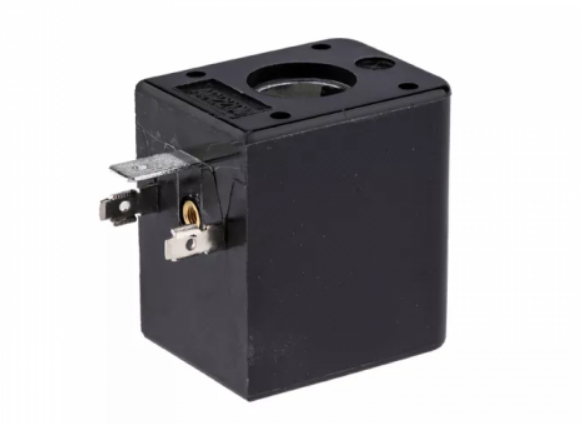A Guide to Solenoid Valve Coil
A is designed to convert electrical energy into lateral motion. Typically made of copper wire wound around a hollow bobbin or tube, the coil generates a magnetic field when an electric current flows through it. Placing the solenoid valve coil over a ferromagnetic core, usually made of magnetic 430F stainless steel armature, causes the magnetic field to move the plunger further into the coil. This movement creates an opening that can control direct-acting solenoid valves, assisted lift solenoid valves, or servo/pressure-assisted solenoid valves.
Solenoid valve coils come in a wide range of sizes, voltages, IP protection levels, temperature ratings, and power levels
Care must be taken when replacing solenoid valve coils, as all these factors must be considered to ensure proper function and compatibility.
Solenoid Valve Coils
A solenoid valve coil is designed to convert electrical energy into lateral motion. Typically made of copper wire wound around a hollow bobbin or tube, the coil generates a magnetic field when an electric current flows through it. Placing the solenoid valve coil over a ferromagnetic core, usually made of magnetic 430F stainless steel armature, causes the magnetic field to move the plunger further into the coil. This movement creates an opening that can control direct-acting solenoid valves, assisted lift solenoid valves, or servo/pressure-assisted solenoid valves.
Solenoid valve coils come in a wide range of sizes, voltages, IP protection levels, temperature ratings, and power levels.
Care must be taken when replacing solenoid valve coils, as all these factors must be considered to ensure proper function and compatibility.
Solenoid Coil Sizing
When measuring a , accuracy is key. Start by measuring the internal diameter of the coil, taking note if there's a top plate with a reduced diameter for secure fitment to the armature/core tube. Then, measure the depth of the internal core. If these measurements match up, you're on the right track to finding the correct coil. A helpful tip: when purchasing solenoid valve coils, try to replace them according to the brand.
Solenoid Coil Voltages
Coils are manufactured for specific voltages, and it's uncommon for a coil to work on more than one voltage, whether AC or DC. While there are instances of "dual voltage coils" that can work on, for example, 12vDC or 24vAC, 48vDC or 24vAC, these are rare and shouldn't be relied upon to address spares shortfalls.
A helpful tip: always check your supply voltage instead of guessing or trying to read the coil voltage.
Solenoid Coil Temperature Ratings
windings come with various temperature ratings, designed based on factors like the media, ambient temperatures, and duty cycle (the ratio of power-on time to power-off cool downtime). Just like a light bulb, all coils generate heat when energized, with higher power consumption resulting in more heat production.
Standard coils are available for insulation classes E, F, and H. The insulation class dictates the maximum operating temperature for a specific life expectancy.
- Class H: 30,000 hours
- Class F: 20,000 hours
Class F coils are rated up to 155°C, meaning the copper wire windings can withstand temperatures up to but not exceeding 155°C. These are commonly used in the pneumatic industry, ideal for ambient temperatures up to 20°C and media temperatures up to 100°C.
Class H coils are rated up to 180°C, suitable for higher temperature applications like steam or hot oil. They work well in ambient temperatures up to 50°C and media temperatures up to 180°C.
Class N coils are rated up to 200°C, designed for extreme applications such as superheated steam. They can handle ambient temperatures up to 80°C and media temperatures up to 200°C.
A helpful tip: Replace brands like for like if experiencing short solenoid coil life. Check supply voltage and application temperature parameters, and ensure none of the internals where the coil sits are stuck or contaminated.
Power Levels for Solenoid Coils
are available in various power levels, with DC coils measured in Watts and AC coils measured in VA (Volt Amps). AC coils typically have a higher inrush current and lower holding current compared to DC coils. This is akin to weightlifting, where lifting a weight requires more energy than holding it up with arms locked.
A helpful tip: Watts = Volts x Amps.
It's crucial to pay attention to the power ratings. Underrated coils can overload and burn out, while coils with too high a power rating may face the same fate.
Another helpful tip: Stick with the same power level unless the coil fails quickly. In such cases, check the voltage supply and current availability, and if necessary, consult your supplier for guidance.
Why Do Solenoid Coils Burn Out?
Solenoid coils are designed to convert electrical energy into mechanical movement through a magnetic field. Similar to a light bulb, they generate heat as they consume power. The higher the wattage or power consumption, or the longer they are switched on, the hotter they can become.
If a coil exceeds its temperature rating (copper winding class rating) due to excessive heat buildup, the copper or insulating material can fail, leading to a short circuit.
Other factors contributing to coil burnout include high media or ambient temperatures, which can hinder proper cooling of the coil, as well as water ingress between the armature and coil. Additionally, removing the coil while it's energized can cause burnout.
Why Does a Coil Get Burnt When Removed from a Valve?
With AC 50/60Hz coils, removing the coil reduces the impedance or resistance of the coil. The shading ring within the armature or stem generates resistance within the coil. Removing the coil while it's powered reduces this resistance, causing an increase in power consumption that can easily surpass the coil winding class limits, resulting in overheating and burnout.

评论
发表评论